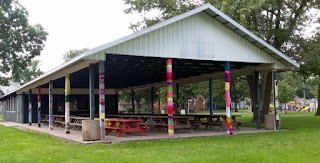 |
| Thin gruel |
In all fairness, the entry in Dean's book for Queen Anne's lace was also for carrot tops - the two plants are cousins - and she did say the color from carrot tops would be richer. But I decided to work with what I had on hand. I made sure there was a LOT of plant material in the dye bath, but the color still seemed rather thin.
 |
| Alum & iron, iron only, alum only, no alum or iron |
The yarn I chose was Valley Yarns Northampton (100% wool), a 100g ball divided into four 25g skeins; since I was already working up a dye bath and an iron after bath, I decided I might as well mordant some yarn with alum too. Again, I used the cool method for mordanting, but I simmered the plant material for a good hour AND let it sit overnight. I also used the hot method on the yarn, simmering it for 45 minutes. Because of bad timing on my part, the yarn cooled in the dye bath for almost 24 hours. I also simmered the yarn in the iron bath, for about 5 minutes.
 |
| Pale yellow |
I'm not very excited with the colors. The yarn that was not modified with iron came out a pale yellow. The yarn that did get modified with iron is kind of an olive green. The alum mordant made only a subtle difference.
 |
| Olive green (sorta) |
That was a lot of work for disappointing results. However, with natural dyeing there are too many variables to predict what will happen. I sample such small amounts I'm sure I can make use of these colors in something.
(Note: in a recent natural dyeing class I took, "simmer" was defined as 190 degrees. Using my ChefAlarm digital thermometer, which allows you to set a minimum and a maximum temperature, I was able to keep the temp between 190 and 200 without standing over the stove obsessively. I highly recommend this product.)


















